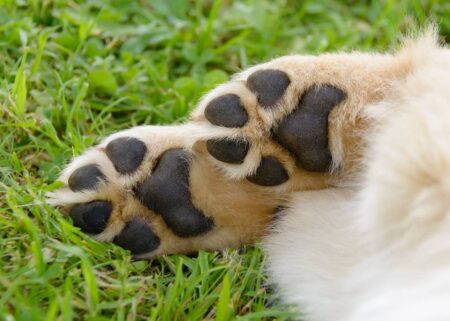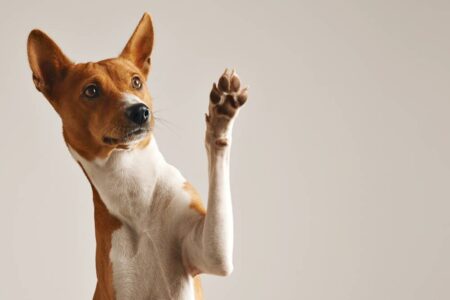
7 Reasons Why Dogs Don’t Like Their Paws Touched
Is your dog resistant to having their paws touched, or even showing signs of discomfort when you try to clean or check them? If so, that is a common issue that can be frustrating for pet owners, but it’s important to understand why this behavior occurs as dogs have sensitive paw pads that are crucial for balance, walking, and running, and they may react negatively if their paws are touched or handled in certain ways.
Today, let us explore some of the most common reasons why dogs dislike having their paws touched and offer you some useful tips on how to help your Dog become more comfortable when handling or touching their paws.
SEE ALSO: Dog Makes Grunting Noises When Sleeping: Causes and Solutions
7 Reasons Why Dogs Don’t Like Their Paws Touched
Here are 7 reasons why dogs may not like their paws touched:
- Dog paws are packed with nerve endings, making them sensitive to touch
- Dogs may associate paw touching with past negative experiences
- Dogs may resist paw touching if they are not fully comfortable with their owner or handler
- Dogs may dislike the sensation of having their paws touched
- Dogs may become stressed or anxious when their paws are touched
- Dogs may feel pain when their paws are touched
- Lack of dog training to accept paw handling
1. Dog paws are packed with nerve endings, making them sensitive to touch
Dogs have a high concentration of nerve endings in their paw pads which makes them highly sensitive to touch and pressure. These nerve endings are crucial for helping dogs maintain balance, navigate their environment, and detect changes in temperature and texture. Because of this heightened sensitivity, many dogs are protective of their paws and may become uncomfortable or even anxious when their paws are touched or handled.
Think of it this way: imagine if someone were to touch a part of your body that was extremely sensitive or ticklish, like the back of your knee or your underarms. You would likely pull away or resist, as the sensation would be overwhelming or unpleasant.
2. Dogs may associate paw touching with past negative experiences
Dogs have excellent memories and can often associate certain experiences, particularly traumatic or negative ones, with specific people, objects, or situations. For example, a dog that has had a painful experience with having their paws handled in the past, such as a nail trimming gone wrong or an injury to the paw, may become wary of anyone who tries to touch their paws in the future.
Similarly, a dog that was mishandled or abused in the past may develop a strong aversion to paw touching due to the negative association.
3. Dogs may resist paw touching if they are not fully comfortable with their owner or handler
Dogs are highly social animals and form strong bonds with their owners or handlers. They learn to trust and rely on the people in their lives, but this process can take time. If a dog is not yet fully comfortable with their owner or handler, it may resist certain types of contact, such as paw touching, out of fear or uncertainty.
In the same way, humans might hesitate to shake hands or hug someone they don’t know very well, dogs may be wary of allowing someone they don’t fully trust to handle their paws.
4. Dogs may dislike the sensation of having their paws touched
Dogs are sensitive to a variety of sensations, and some may find the physical feeling of paw touching to be uncomfortable or unpleasant. For example, some dogs may dislike the pressure or the sensation of being held or restrained, while others may find the warmth of a human hand on their paws to be uncomfortable.
Just like people have different preferences for physical touch, so do dogs. Some may enjoy having their paws rubbed or massaged, while others may prefer to keep their paws to themselves and that is why it’s important to observe your dog’s body language and reactions to paw touching to get an idea of how they feel about it.
5. Dogs may become stressed or anxious when their paws are touched
When dogs become stressed or anxious, their body undergoes several physiological changes that can make them more sensitive to touch and other stimuli. This can be particularly true when their paws are handled, as the paws are a very sensitive area.
The stress response in dogs can lead to an increase in adrenaline and cortisol levels, making them more alert and potentially anxious. In some cases, dogs may even exhibit signs of fear or aggression when their paws are touched, as a way of protecting themselves from perceived threats.
6. Dogs may feel pain when their paws are touched
Dogs can experience a variety of types of pain in their paws, ranging from minor discomfort to serious injuries. For example, if a dog has a foreign object lodged in their paw pad or if they have a fracture or other injury, paw touching can be extremely painful.
Even minor issues like soreness from walking on rough surfaces or having overgrown nails can cause discomfort when the paws are handled. Dogs that are experiencing pain in their paws may pull away, yelp, or even nip at the person trying to touch them, as a way of signaling their discomfort.
7. Lack of dog training to accept paw handling
Dogs that haven’t been trained to accept paw handling may resist it simply because they haven’t learned that it’s safe and normal. In the same way that you might need to train a dog to accept wearing a collar or walking on a leash, some dogs need to be taught that paw handling is a routine part of pet care.
Without proper training, dogs may view paw handling as something to be feared or avoided, rather than something necessary for their well-being. This can lead to resistance, avoidance, or even aggression when their paws are touched.
Why Do Dogs Not Like Their Nails Cut?
Dogs often dislike having their nails cut for several reasons:
- Pain or Discomfort: Cutting too close to the quick (the blood vessel in the nail) can cause bleeding and discomfort, making the experience unpleasant.
- Anxiety or Fear: The sound and sensation of nail clipping can be anxiety-inducing for some dogs, especially if they have had a negative experience in the past.
- Lack of Trust: If your dog is not comfortable with being handled, especially around their paws, they may resist nail clipping out of fear or distrust.
- Unfamiliarity: If your dog is not used to having their nails trimmed, they may view it as a strange or uncomfortable experience.
- Resistance to Restraint: Some dogs may not like being restrained or held in place during nail clipping, especially if they are anxious or resistant to handling.
- Lack of Positive Association: If nail clipping is always associated with negative experiences, such as scolding or punishment, your dog may learn to dislike the activity.
Are Dogs Paws Sensitive to Touch?
Yes, dogs’ paws are very sensitive to touch. They have a high concentration of nerve endings in their paw pads, making them extremely sensitive to pressure, temperature, and texture. This sensitivity helps dogs navigate their environment and stay balanced, as well as protecting them from potential injuries.
However, this sensitivity can also make paw handling uncomfortable or even painful for dogs, especially if they are not used to it. For example, many dogs resist having their nails trimmed or their paws handled because of the sensitivity of their paw pads.
Are Dogs Front Paws More Sensitive Than Back Paws?
In general, dogs’ front paws tend to be more sensitive than their back paws, due to the higher concentration of nerve endings in the front paws. This increased sensitivity allows dogs to have a better sense of balance and stability, as well as better touch and dexterity.
However, the level of sensitivity can vary from dog to dog, and some may have more sensitive back paws than front paws. It’s important to observe your dog’s behavior and reactions to determine which areas are most sensitive.
How to Get Your Dog Used to Have Their Paws Touched
Here are some steps you can take to help your dog become more comfortable with having their paws touched:
- Start with Gentle Touch: Gently touch your dog’s paws for brief periods, starting with the pads and then moving to the nails. Pair the touching with praise and treats to create a positive association.
- Gradually Increase Duration and Pressure: Over time, gradually increase the length of time you touch your dog’s paws and the amount of pressure you apply, always rewarding your dog for calm behavior.
- Introduce Nail Clippers: Once your dog is comfortable with paw touching, introduce the nail clippers. Let your dog sniff and investigate the clippers, and give them a treat for staying calm.
- Desensitize to the Clippers: Gradually introduce the clippers while your dog is receiving treats, starting by lightly touching the nails and then gradually increasing the pressure.
- Clip Just One Nail at a Time: When you start clipping your dog’s nails, only clip one nail at a time, giving praise and rewards for calm behavior. Gradually increase the number of nails you clip each session.
- Take Breaks: If your dog becomes anxious or resistant during the nail clipping process, take a break and return to gentle paw touching and rewards. This helps prevent your dog from becoming overwhelmed.
- Use Positive Reinforcement: Make sure to reward your dog for calm behavior during and after the nail-clipping process. This can include treats, toys, or praise, depending on what your dog finds most rewarding.
- Seek Professional Help: If your dog continues to struggle with nail clipping, consider seeking help from a professional groomer or veterinary technician.
What Does it Mean When A Dog Lets You Touch Their Paws?
When a dog allows you to touch their paws, it can be a sign of trust and comfort. Here are a few possible interpretations:
- The dog trusts you: If a dog allows you to touch their paws, it means they trust you and feel safe with you. They may see you as a friend or protector and are comfortable with you handling their sensitive areas.
- The dog is seeking attention: Dogs often seek attention by presenting their paws to their owners. This can be a way for them to ask for pets or scratches.
SEE ALSO: Dog Walking Tips for Less Than Perfect Weather Conditions
FAQs
Q. Why does my dog get aggressive when I touch his paws?
Your dog may get aggressive when you touch his paws due to fear, pain, or a lack of trust. Consider addressing these issues through positive reinforcement and desensitization training.
Q. Why don’t German shepherds like their paws touched?
German Shepherds are often sensitive to having their paws touched due to their breeding as herding dogs, which requires high paw sensitivity for directional steering and agility.
Q. Do dogs like having their paws rubbed?
Some dogs enjoy having their paws rubbed, while others find it uncomfortable or even painful. Individual dogs’ preferences can vary greatly.


